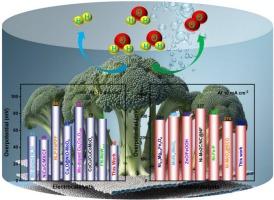High-performance multimetal broccoli-like structure MnMoO4/CoWO4/NF nanocomposite as a bifunctional electrocatalyst for efficient water splitting
IF 4.1
3区 化学
Q1 CHEMISTRY, ANALYTICAL
引用次数: 0
Abstract
Developing high-performance bifunctional water-splitting electrocatalysts is attractive for sustainable energy applications, yet significant challenges remain. Enhancing interfacial properties within heterostructured metal oxide composites offers a pathway to overcoming these limitations, such as the high cost of precious metal benchmarks and suboptimal reaction kinetics caused by intrinsic scaling relationships, by optimizing charge transport and reaction energetics. Designing advanced nanostructures with synergistic interactions between components can lower energy barriers and improve catalyst performance. In this work, a broccoli-like MnMoO₄/CoWO₄/NF nanocomposite was synthesized via a hydrothermal method. This heterostructured electrocatalyst features an engineered crystalline interface layer and leverages the synergistic effects among the multimetal oxide components. Density functional theory (DFT) calculations were employed to analyze the electronic properties, including the density of states near the Fermi level and Gibbs free energy changes (ΔGH*, ΔGO*, ΔGOH*, ΔGOOH*) for key intermediates involved in water splitting reactions. The MnMoO₄/CoWO₄/NF electrocatalyst exhibited exceptional bifunctional catalytic activity, requiring overpotentials of 258 mV for the oxygen evolution reaction (OER) and 42 mV for the hydrogen evolution reaction (HER) to reach a current density of 10 mA·cm−2. The material demonstrated outstanding stability over 150 h of chronopotentiometry testing. The combination of experimental results and DFT analysis confirms the effectiveness of the interface engineering strategy in promoting superior catalytic performance for overall water electrolysis.

高性能多金属花椰菜状结构MnMoO4/CoWO4/NF纳米复合材料作为高效水分解双功能电催化剂
开发高性能双功能水分解电催化剂对可持续能源应用具有吸引力,但仍存在重大挑战。通过优化电荷输运和反应能量学,增强异质结构金属氧化物复合材料的界面性能为克服这些限制提供了一条途径,例如贵金属基准的高成本和由固有标度关系引起的次优反应动力学。设计具有组分间协同作用的先进纳米结构可以降低能垒,提高催化剂性能。采用水热法制备了一种类似西兰花的MnMoO₄/CoWO₄/NF纳米复合材料。这种异质结构电催化剂具有工程结晶界面层,并利用了多金属氧化物组分之间的协同效应。利用密度泛函理论(DFT)计算分析了水分解反应中关键中间体的电子性质,包括费米能级附近的态密度和吉布斯自由能变化(ΔGH*, ΔGO*, ΔGOH*, ΔGOOH*)。MnMoO₄/CoWO₄/NF电催化剂表现出优异的双功能催化活性,析氧反应(OER)和析氢反应(HER)分别需要258 mV和42 mV的过电位才能达到10 mA·cm−2的电流密度。该材料在150小时的时间电位测定测试中表现出出色的稳定性。实验结果与DFT分析相结合,证实了界面工程策略在提高整体水电解催化性能方面的有效性。
本文章由计算机程序翻译,如有差异,请以英文原文为准。
求助全文
约1分钟内获得全文
求助全文
来源期刊
CiteScore
7.80
自引率
6.70%
发文量
912
审稿时长
2.4 months
期刊介绍:
The Journal of Electroanalytical Chemistry is the foremost international journal devoted to the interdisciplinary subject of electrochemistry in all its aspects, theoretical as well as applied.
Electrochemistry is a wide ranging area that is in a state of continuous evolution. Rather than compiling a long list of topics covered by the Journal, the editors would like to draw particular attention to the key issues of novelty, topicality and quality. Papers should present new and interesting electrochemical science in a way that is accessible to the reader. The presentation and discussion should be at a level that is consistent with the international status of the Journal. Reports describing the application of well-established techniques to problems that are essentially technical will not be accepted. Similarly, papers that report observations but fail to provide adequate interpretation will be rejected by the Editors. Papers dealing with technical electrochemistry should be submitted to other specialist journals unless the authors can show that their work provides substantially new insights into electrochemical processes.

 求助内容:
求助内容: 应助结果提醒方式:
应助结果提醒方式:


